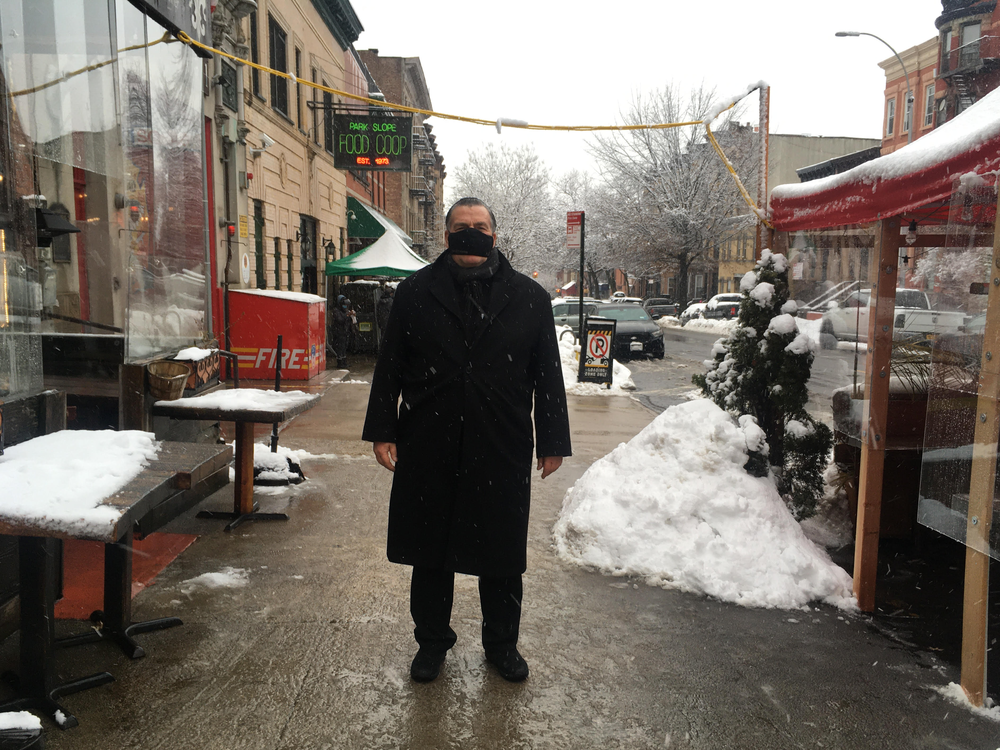Section Branding
Header Content
New York Restaurants Hope To Avoid Heartbreak On Valentine's Weekend
Primary Content
Scottadito Osteria Toscana Restaurant is a typical Brooklyn neighborhood spot, with high ceilings and dark wood. Inside the front door is a table with a white cloth. It's piled with round plates, wine glasses, and two silver pitchers of water. There are also clear plastic pump dispensers of hand sanitizer and a thermometer.
"When people come in, we take their temperature," says owner Donald Minerva. "It's a pretty big imposition to put people in. But this is what we have to do."
Minerva is standing next to an iPad screen filled with a spreadsheet. The state encourages the restaurant to record contact information for anyone who eats inside.
"Take their temperature. Take their address. Take their phone number," he says.
What Minerva would really like to take is more reservations for Valentine's Day, which is normally one of the restaurant industry's busiest holidays of the year.
In a regular year, he says, his restaurant would have 250 reservations for February 14. But this year, with people worried about getting COVID-19, bookings are down to just a third of that. And, he says the math is complicated. Even if a restaurant is technically allowed to fill 25% of its tables, once you space those tables six feet apart, that usually means less than one-quarter of your normal capacity.
In New York, restaurants had been barred from indoor seating since December. When Gov. Andrew Cuomo cleared them for indoor dining at 25% capacity just before Valentine's Day, reservations for the holiday quadrupled, according to OpenTable, a restaurant reservation site. But they're still just half of what they were last year.
The CDC categorizes indoor dining at restaurants as higher risk. And only a tiny percentage of New York City's food service workers have received the vaccine, so advocates say serving indoors puts them at risk. All of this means the restaurant business is wildly unpredictable. That's why a few feet away in the kitchen, chef Raffaele Spadavecchia is leaning over a large aluminum foil pan filled with roasted potatoes and Italian sausage. Nowadays the kitchen often ends up with extra food. So Spadavecchia sprinkles some chopped, vibrant, fresh green basil on the pan of warm potatoes. He picks it up and he and Minerva walk outside and head next door, where they ring the buzzer next to their neighbor's bright red garage door. It's a fire house: FDNY Squad 1. "Hey guys, we bring some snacks for you," Spadavecchia says as the door opens.
"You guys are the best," replies a fireman, reaching for the aluminum tray.
But restaurants are supposed to sell food, not give it away. Minerva has had to take out $275,000 in PPP and disaster relief loans to stay afloat. And even so, he's had to let almost half his staff go.
According to the New York State Restaurant Association, one out of every six restaurants has shut down since the pandemic began.
Across the city in Queens, Dan Connor is also thinking hard about Valentine's Day. He's the co-owner of a restaurant that took a big hit on a different holiday back when the pandemic began.
"The first night we were closed was March 16th of 2020. That's when they told us to shut the doors, with no warning," he says.
The next day was St. Patrick's Day. And Connor's restaurant is called Donovan's. It's an Irish Pub.
"We had three thousand pounds of corned beef sitting there ready to go. And that's lost," he says.
A lot of corned beef ended up in the trash. But he was able to keep going. A non-profit began ordering lunch and dinner for doctors and other front line workers from the pub. Still, Connor says best case this Valentine's Day he just wants to cover his bills - to keep his staff working. A year ago the pub had 16 employees, he says. Now it's running on five.
Connor says smart restaurateurs will order carefully for Valentine's Day. They can't afford to get stuck with their equivalent of thousands of pounds of corned beef.
And he's hopeful the pub will survive. Connor and his staff filmed a video to apply for an emergency small business grant and posted it on YouTube. A customer saw it and created a Go-Fund-Me page for the pub. It's been viewed thousands of times and raised tens of thousands of dollars – with each tiny, electronic ping a sort of Valentine, expressing love pandemic-style.
Back at Scottadito Osteria Toscana in Brooklyn, the head bartender is stuffing envelopes. Inside are paper menus – also Valentines of sorts — to send to neighborhood residents in hopes of wooing them back. "We need a lot of love," Spadavecchia says.
Copyright 2021 NPR. To see more, visit https://www.npr.org.

